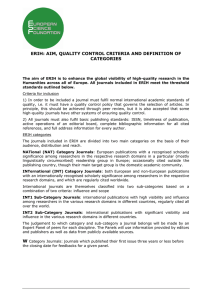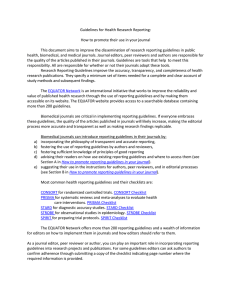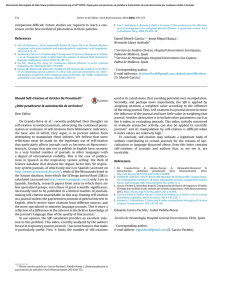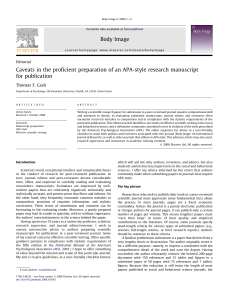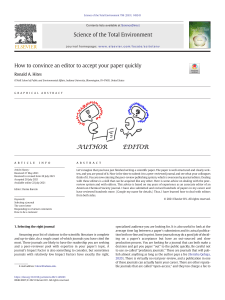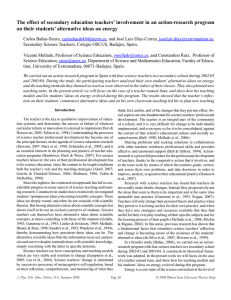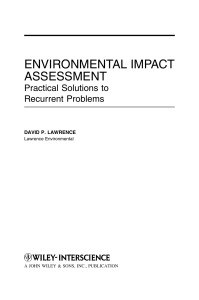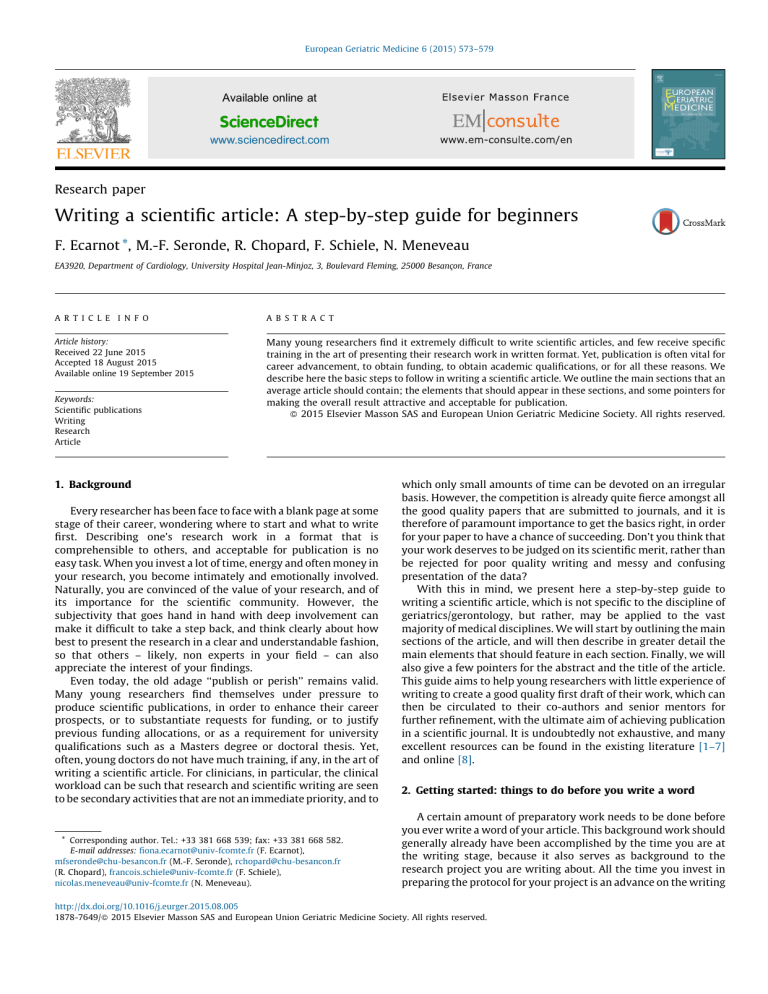
European Geriatric Medicine 6 (2015) 573–579 Available online at ScienceDirect www.sciencedirect.com Research paper Writing a scientific article: A step-by-step guide for beginners F. Ecarnot *, M.-F. Seronde, R. Chopard, F. Schiele, N. Meneveau EA3920, Department of Cardiology, University Hospital Jean-Minjoz, 3, Boulevard Fleming, 25000 Besançon, France A R T I C L E I N F O A B S T R A C T Article history: Received 22 June 2015 Accepted 18 August 2015 Available online 19 September 2015 Many young researchers find it extremely difficult to write scientific articles, and few receive specific training in the art of presenting their research work in written format. Yet, publication is often vital for career advancement, to obtain funding, to obtain academic qualifications, or for all these reasons. We describe here the basic steps to follow in writing a scientific article. We outline the main sections that an average article should contain; the elements that should appear in these sections, and some pointers for making the overall result attractive and acceptable for publication. ß 2015 Elsevier Masson SAS and European Union Geriatric Medicine Society. All rights reserved. Keywords: Scientific publications Writing Research Article 1. Background Every researcher has been face to face with a blank page at some stage of their career, wondering where to start and what to write first. Describing one’s research work in a format that is comprehensible to others, and acceptable for publication is no easy task. When you invest a lot of time, energy and often money in your research, you become intimately and emotionally involved. Naturally, you are convinced of the value of your research, and of its importance for the scientific community. However, the subjectivity that goes hand in hand with deep involvement can make it difficult to take a step back, and think clearly about how best to present the research in a clear and understandable fashion, so that others – likely, non experts in your field – can also appreciate the interest of your findings. Even today, the old adage ‘‘publish or perish’’ remains valid. Many young researchers find themselves under pressure to produce scientific publications, in order to enhance their career prospects, or to substantiate requests for funding, or to justify previous funding allocations, or as a requirement for university qualifications such as a Masters degree or doctoral thesis. Yet, often, young doctors do not have much training, if any, in the art of writing a scientific article. For clinicians, in particular, the clinical workload can be such that research and scientific writing are seen to be secondary activities that are not an immediate priority, and to * Corresponding author. Tel.: +33 381 668 539; fax: +33 381 668 582. E-mail addresses: fi[email protected] (F. Ecarnot), [email protected] (M.-F. Seronde), [email protected] (R. Chopard), [email protected] (F. Schiele), [email protected] (N. Meneveau). which only small amounts of time can be devoted on an irregular basis. However, the competition is already quite fierce amongst all the good quality papers that are submitted to journals, and it is therefore of paramount importance to get the basics right, in order for your paper to have a chance of succeeding. Don’t you think that your work deserves to be judged on its scientific merit, rather than be rejected for poor quality writing and messy and confusing presentation of the data? With this in mind, we present here a step-by-step guide to writing a scientific article, which is not specific to the discipline of geriatrics/gerontology, but rather, may be applied to the vast majority of medical disciplines. We will start by outlining the main sections of the article, and will then describe in greater detail the main elements that should feature in each section. Finally, we will also give a few pointers for the abstract and the title of the article. This guide aims to help young researchers with little experience of writing to create a good quality first draft of their work, which can then be circulated to their co-authors and senior mentors for further refinement, with the ultimate aim of achieving publication in a scientific journal. It is undoubtedly not exhaustive, and many excellent resources can be found in the existing literature [1–7] and online [8]. 2. Getting started: things to do before you write a word A certain amount of preparatory work needs to be done before you ever write a word of your article. This background work should generally already have been accomplished by the time you are at the writing stage, because it also serves as background to the research project you are writing about. All the time you invest in preparing the protocol for your project is an advance on the writing http://dx.doi.org/10.1016/j.eurger.2015.08.005 1878-7649/ß 2015 Elsevier Masson SAS and European Union Geriatric Medicine Society. All rights reserved. 574 F. Ecarnot et al. / European Geriatric Medicine 6 (2015) 573–579 of the article that will come out of your project. Thus, you probably already performed an extensive literature review to establish the current state of knowledge on the topic, and ensure the originality of your research when developing the protocol, and this can serve for your paper. It is helpful, when you are reviewing the literature, to take notes of important points or phrases that you intend to include in your article, with the relevant references. A software program for managing references (either free versions or commercially available products) can be helpful for managing the large volume of references that you are likely to wade through before sifting out the most important points. Usually, you will also have the final results of the statistical analysis of your data. This will form the basis of your results section. Some of the graphical representations of your results will serve as figures for the article, so it is helpful to highlight the most important findings as you read through the results so that you do not forget anything important. Before starting to write, you should identify the target journal in which you intend to submit your research. This will have consequences for the formatting, but more importantly, for the orientation of your writing style, since the writing must be appropriate for the type of reader you are targeting. For example, are you targeting a specialist journal, where readers are expected to be experts in your field, or a general medicine journal, where readers may be experts from other disciplines? This will have implications for the amount and type of information that you must include. In addition, the editorial policy of the target journal should also be taken into account. For instance, in a given area of expertise, some journals favour papers reporting basic research, whereas other journals give precedence to more clinical work. The choice of the target journal depends on a range of factors, which are beyond the scope of this article. However, at the very least, you should check that your paper falls within the scope of the journal you have chosen. 3. What are the main sections of a scientific article? The vast majority of scientific journals follow the so-called ‘‘IMRAD’’ format, i.e. introduction, methods, results and discussion. Naturally, there are some exceptions to this rule, and you should always check the instructions for authors of the journal where you plan to submit your paper to ensure that this is indeed the recommended format. For the purposes of this guide, we will only discuss the IMRAD format, as it is the most widely used. Your article should thus contain (in this order) an introduction, a methods section, a results section and a discussion. Added to this will be the abstract, which is more or less a summary of these main sections, and of course, the title. At the end, there must be a list of bibliographic references, the tables, and the legends to any figures. Finally, there may also be some other optional sections, such as acknowledgements, conflicts of interest or authors’ contributions. Below, we will discuss each of these sections in detail, outlining the main points to keep in mind when writing them. 3.1. The introduction section The introduction is of prime importance in grabbing the reader’s attention (Table 1). In particular during the review process, the introduction must get the reviewer ‘‘hooked’’, wanting to read more, and thinking to themselves, ‘‘How come I never thought of this?’’. In this section, you will thus explain why you undertook your study, what you aimed to achieve with it, and how this constitutes a useful addition to the existing body of evidence on this topic. In concrete terms, you should start by explaining briefly, using appropriate references, what is already known about this subject. You should then narrow the field down somewhat and identify the areas where there is still some uncertainty, citing, where appropriate, any previous (and possibly conflicting) data. This will logically lead to a description of an explicit gap in the knowledge that your study hopes to fill. This is an essential element in justifying the utility of your work. Having now explained how your study is going to contribute something new and useful, you should clearly state your working hypothesis, followed by your objective(s), and very briefly, the strategy implemented to achieve these goals (Table 1). In the background, the reasons that prompted you to undertake your research should be clear to the reader, and justified by the state of scientific knowledge with appropriate references. It is not necessary to cite every article in the literature on the topic; a careful selection of the most pertinent publications is sufficient. Similarly, it is not necessary to state universal truths that may seem over simplistic or eminently obvious. Yet you should try to achieve a suitable balance between relevant background information, and excessive detail. In this regard, you should keep in mind the target audience you are aiming for. This will depend on the profile of the readership of the journal in which you intend to submit your research, as mentioned above. If you are targeting a specialty journal, then your background can be more detailed and technical than if you are addressing an audience of non-specialists in your field. The introduction should logically flow towards the identification of the gap in knowledge that you hope to fill. This is your opportunity to state the added value of your study, or the new information that your study will yield. Will your results change clinical practice? Will they help the scientific community at large to move towards consensus on a previously controversial topic by providing hard evidence in one direction or the other? This is your chance to make a sales pitch for your article, in the appropriate terms, of course. As far as possible, try to avoid diverging from the subject at hand. Every sentence should serve a purpose. Many journals have a limit on the length of the introduction, with a maximum number of Table 1 Outline of the main features of the Introduction section, with examples. Feature Example Background describing what is known on the subject Percutaneous coronary intervention is the cornerstone of therapy for acute coronary syndromes, but may be associated with procedure-related complications It remains unknown whether. . . To date, it has not been proven. . . No study to date has investigated the effect of. . . There are few data to quantify. . . The effect of. . . on. . . remains unclear We hypothesized that the administration of. . . would reduce/increase. . . in the context of. . . We aimed to identify/assess/evaluate/investigate. . . Through a prospective, single-/multicentre, observational/interventional. . . study What is not known? What elements are still subject to controversy? What is the exact gap in the knowledge that your study hopes to fill? Cite any existing data, especially conflicting data that indicate uncertainty Objective ( working hypothesis) Cite the exact parameter you plan to measure Cite the type of patient population or clinical context Cite any secondary objectives F. Ecarnot et al. / European Geriatric Medicine 6 (2015) 573–579 words or pages allowed, so you are going to have to stay focused. You should check the instructions for authors of your target journal carefully for any indications regarding the appropriate length for the introduction. In the absence of any explicit recommendations, it is considered that the introduction should be around one to one and a half pages. The formulation of your objective is of paramount importance, and you should take the time to think about this carefully. The objective must be explicitly stated, and should include the exact parameter you aim to assess, and by what means. The aim of your study as stated in the article is the same as the aim formulated in your study protocol (don’t forget – every research project should have a written protocol before starting!). It is helpful to choose one formulation for your objective, and use the same one throughout the whole paper, i.e. in the introduction, the results, the discussion, the abstract and even partially, in the title. Do not be afraid of appearing repetitive; repetition is not necessarily a bad thing in an article. It shows the reader at least that you know what you are talking about, and using the same terms throughout avoids any confusion. Lastly, a word about the tense to use in the introduction. For many researchers, English is not their native language, and this is an additional difficulty in the writing process that needs to be overcome. You should try to avail of any resources available to you to help you with the quality of your written English. Many large institutions have translators or scientific writers who may be able to translate or correct your text. For those who are not lucky enough to have such resources at their disposal, you should look to important publications in good quality journals for examples of the desired format. Pointers for the tense to use in the introduction are given in Table 2. 3.2. The methods section The objective of the methods section is to describe exactly what you did, and how, in sufficient detail such that any average reader with the same resources at their disposal would be able to reproduce your study. There must be a method described for every result you intend to include in your results section – i.e., you cannot present the results of a test or analysis that was not mentioned in the methods. Conversely, if details of any or all procedures have previously been published elsewhere, then a brief summary will suffice, accompanied by a reference to the relevant publication. You should start by specifying the design of the study (prospective/retrospective, randomized or non-randomized, double-blind or open-label, controlled, crossover, factorial. . .). Any choices of unusual methodology for the design of the study should be justified, either by appropriate references or guidelines, or an explanation of the specific context calling for your particular approach. Next will follow the description of whom or what you studied, i.e. the study population (animals, human subjects, cells. . .). For the vast majority of clinicians, the study population will comprise human subjects, and so, the inclusion and non-inclusion 575 should be detailed. The procedures for identifying eligible patients should also be outlined (consultations, new admissions, daily rounds, staff meetings, case review meetings etc). It should be noted that for retrospective studies, the methods should begin with a description of the source data for the study, namely the inclusion and non-inclusion criteria and the final number of case records and/or patients selected. However, for prospective studies, the methods should describe the inclusion and non-inclusion, but the final number of patients included is considered as a result and therefore, should be indicated in the results section, and not in the methods. After describing the study population, you may proceed to describe all the methods used to measure all the major parameters recorded in your study. You must specify the primary and secondary endpoints, with the methods used to measure them. This is absolutely fundamental, since the choice of the primary endpoint is critical to the success of the study. It is the sole criteria that allows you to draw formal conclusions about the outcome of the study, and thus, must be carefully selected. Again, this point will already have been considered in depth during the planning phase. This underlines once again how the writing of your article is greatly facilitated by proper discussion and reflection at the planning stage of your research project. Coming back to the methods, every blood test, intervention, operation, questionnaire, imaging technique etc should be detailed, where necessary providing the manufacturer details (manufacturer’s name, city and country of company) for any specific equipment or tests used. Short sentences may be used to explain why each measurement was taken. Subtitles can also be useful to separate the methods section into relevant subsections, e.g. demographic data, angiographic measures, treatment. . . A short note regarding ethical considerations must be included in the methods section, stating briefly that ethics committee approval was obtained for the study (or if not, explain why). You must also confirm that written informed consent was obtained from all subjects, or from their next of kin, or surrogate, where appropriate. In the case of randomized clinical trials, it is also advisable to indicate that the study has been registered with an approved clinical trial database (e.g. www.clinicaltrials.gov), citing the registration number. Most journals request that the name of the ethics committee and the date of approval be specified, and some may even require the file number to be given. There may also be varying recommendations about where to include all this information. Again, refer to the instructions for authors of your target journal for guidance. Lastly, the final paragraph of the methods section should detail the statistical analysis. Standard statements about the presentation of the data should come first; for example, quantitative, normally-distributed data are presented as means standard deviation, or median [interquartile range] for non-normally distributed data, and qualitative data as number (percentage). Then, the specific statistical approaches used should be listed – which test for which type of variable; type of multivariate analysis and the variables Table 2 Suggestions for the tense to use when writing your introduction section. Aim Tense Example To describe the current state of knowledge To describe observations previously published by others Present Past (imperfect) To describe a process that began at some unspecified time in the past, and is not yet complete To describe something that has not happened yet To formulate your hypothesis Present perfect Cancer is a common disease Smith et al. showed that drug A reduced the rate of death, whereas drug B did not Several researchers have investigated the effect of drug A on this disease It has not yet been determined whether. . . We hypothesized that drug A increases the risk of bleeding To formulate your objective Present perfect Past tense for first verb Present tense for second verb Past tense We aimed to measure. . . 576 F. Ecarnot et al. / European Geriatric Medicine 6 (2015) 573–579 included in it; approach used for survival analysis. . . The sample size justification can be included here, stating the working hypothesis for the frequency of the outcome and its variance, the difference you expect to observe, and the alpha and beta risks used for your calculations. The level of significance for the analyses, as well as the software used should also be included. Any planned sub-group analyses should be detailed in this paragraph, in order to avoid potential criticisms about post hoc studies in non-predefined subgroups. It must be remembered that planned subgroup analyses have an impact on the calculation of the sample size, and the use of multiple analyses may require Bonferroni’s correction to ensure that the alpha risk is not inflated. These considerations – again, having previously been worked out during the development of the project – must be detailed in the statistical analysis section. If you are suitably qualified in methodology and statistics, then this section will not pose any problem. If you are less at ease with statistics, your project undoubtedly had methodological support from a qualified methodologist and/or statistician, so you may solicit their contribution for this section of the manuscript in order to ensure accuracy and exhaustiveness. A suggested list of items to be covered in the methods section for retrospective and prospective studies is given in Table 3. As regards the tense to use for your writing, the methods should mainly be described using the past (imperfect) tense, i.e. we performed, we recorded, we measured, we tested. . . The pastperfect tense should be used to describe events occurring before your study, i.e. ‘‘when thrombolysis had failed, we initiated. . .’’. 3.3. The results section The aim of the results section is to describe what you observed, without commentary or discussion. It is no longer necessary to describe the methods; this has already been done in the methods section, so just give the result. The reader will remember what methods were used if they read the methods section attentively. It is also unnecessary to comment, or interpret, so phrases such as ‘‘surprisingly. . .’’ or ‘‘interestingly’’. . . are generally deemed to be out of place in the results section. You must describe a result for every method that was outlined in the methods section, and to make the paper easier to follow and read, it is good practice to present the results in the same order as the methods. Similarly, use of subtitles (again, the same ones as used in the methods section), can help to break down the results into easy-to-follow sections. A typical paragraph of results should start by recalling the type of analysis (e.g. ‘‘QCA analysis revealed that. . .’’), then detail the results observed, referring to the relevant tables or figures (e.g. ‘‘the number of lesions was significantly higher in group A compared to group B’’). As for the methods, the results should be presented using the past (imperfect) tense: e.g. ‘‘serum creatinine was correlated with glomerular filtration rate’’. Table 3 Suggested list of items to be included in the methods section for retrospective and prospective studies. Retrospective study Prospective study Subjects Inclusion and non-inclusion criteria Ethical considerations (ethics committee approval, name of committee, date and file number, informed consent) Primary endpoint Secondary endpoints Statistical analysis Data recorded Study registration, if randomized Source(s) of study data Sample size calculation Subgroups (if any) Randomization procedure Number of subjects/samples Interventions A major question for many researchers when writing the results section is whether to describe the results in the text, or use a table or figure. While there are no strict rules for this, in general, results that can easily be described in one or two lines can be written in the text. Tables should be used for data such as baseline characteristics, outcomes, treatments, where the same variables are being described for two or more groups. Tables also generally contain the most important results, and on their own, should be sufficient to give the reader a clear idea of your findings. Figures are useful in cases where the source data is either too complex for presentation or not easily interpretable. Relationships and trends are amenable to graphical presentation in figures. There may be a limit to the total number of illustrations (figures and tables) that you are allowed, depending on the target journal, so again, check for guidance before including too many. Pay attention also not to include too many illustrations, so that they do not lose their interest, and above all, do not repeat data in the text that already appears in a table or figure. 3.4. The discussion section This discussion is where you interpret and explain the significance of your results, and how they fit into the wider picture of what has already been observed and reported on the same topic. The discussion should start with a brief recap of the main findings of your study, preferably using the same formulation as that used for the primary objective (in the introduction) and the primary endpoint (in the methods). This can be followed by the interpretation of your results. Pay attention when interpreting not to simply repeat the results, or at the other end of the scale, not to over-interpret. You should present your findings factually; after all, this is a scientific article, not a prose novel. For example, if you state in your results that ‘‘After administration of drug X, 20 out of 25 patients experienced intracranial bleeding’’, then it is not accurate to indicate in the discussion that ‘‘80% of patients who receive drug X have intracranial hemorrhage’’. This is a subtle shift in interpretation that belies that original data. It would be more accurate, for example, to suggest that ‘‘our results indicate that drug X may have significant adverse effects’’. Putting your results in perspective with other reports is an important part of the discussion. How do your results compare to other reports in the literature? If your findings are different, do you have any plausible explanations? What are the possible discrepancies in circumstances, populations or approaches that may explain why you observed what you observed? Any particularly surprising or interesting findings should be discussed and potential explanations put forward. Can your findings be extrapolated to other contexts or populations, and if not, why not? If multiple analyses or interventions were performed, you should go beyond focusing on individual results to explain what the overall significance of the results is, when all tests or analyses are taken together. In doing this, you will naturally want to describe what other authors have reported in similar contexts, in order to compare to your own findings. Remember, it pays to be diplomatic when criticizing the work of others. Instead of pointing out weaknesses in other people’s work, reformulate so as to present the strong points of your own work – the implication will be obvious, without you having to explicitly criticize your peers’ publications. For example, instead of asserting that ‘‘Smith’s study was underpowered’’, it is helpful to use a softer tone and a more precautious formulation, such as ‘‘Smith’s study may have been underpowered’’, or better yet, ‘‘Our study had sufficient statistical power to detect’’. . . In the context of a direct comparison, this will implicitly imply to the reader that Smith’s study may not have had sufficient power. For readers whose native language is not English, you should exercise caution when paraphrasing in order not to change F. Ecarnot et al. / European Geriatric Medicine 6 (2015) 573–579 the emphasis of the sentence. The order in which the results or elements of discussion are mentioned may subtly move the emphasis away from that originally intended by the other author. Here again, careful re-reading by co-authors and senior mentors, or members of your publications department (if you have one), will help to avoid these pitfalls. What are the novel findings of your study? Underlining how your findings yield new evidence or a new contribution to the state of knowledge will substantiate the importance of your paper, and its added value for the literature, as opposed to being ‘‘just another paper’’ on a ‘‘worn-out’’ topic. In this regard, you can discuss whether or not your paper has succeeded in filling the ‘‘gap in knowledge’’ that you justified in the introduction. Do not be afraid to write an article reporting negative results. A well-conducted study that does not yield positive results is always a useful contribution to the current body of evidence, and you may suitably discuss what the repercussions of this may be. For example, it may serve to advance knowledge in the field by calling into question widely held ideas, or by challenging previous findings, or by reinforcing a small body of conflictual data that may previously have been considered merely ‘‘anecdotal’’. As long as your study has been well designed and conducted appropriately, there is no reason to believe that your findings are not valid, even if they are negative. In practical terms, you may indicate how your results are likely to influence practice, or the state of knowledge. For example, will your results sway the general opinion one way or the other? You may also indicate any potential avenues for future research, particularly new hypotheses that may have been generated by observations on your secondary objectives. Finally, a short paragraph outlining the strengths and limitations of your study is useful. In particular, enumerating your limitations has several advantages. Firstly, it allows the reviewers to see that you are aware of your own shortcomings, and secondly, it provides an opportunity for you to defend yourself on these points, and state why the supposed limitation may not be so negative after all. 3.5. The abstract The abstract is a short summary of the article in a few sections (usually background, methods, results, conclusion). It is used for referencing purposes in online bibliographic databases (such as PubMed), and therefore should form an independent unit that is comprehensible as a stand-alone text, without the need to refer to 577 the full text. It is also usually the first item that a potential reviewer will see when being invited to review your paper for publication in a journal. Therefore, it is of paramount important that the abstract be succinct, but informative and attractive, to give the potential reader a foretaste of the main information, and incite the desire to read the full paper. It is the quintessential marketing tool for your work, so it is worth devoting some time and special thought to its preparation. There are a few main points to remember for the preparation of the abstract, but space is limited, so you must keep it short. The main pointers for the abstract are outlined in Table 4. If you have given sufficient time and thought to preparing your project, and writing the resulting article, the preparation of the abstract should not be time-consuming. You will easily find a sentence or two in the introduction that can be re-used in the abstract (perhaps with some shortening necessary). Similarly, the results will be mainly copy-and-pasted from the results section of the article. The conclusion can be formulated as the main take-home message to come out of your work. Indeed, the hardest part of the abstract is often shortening it sufficiently to fit with the word limit of your target journal. 3.6. The title Last but certainly not least, is the title of your article. The title should contain keywords to reflect the main issues in your article. It should also awaken the potential reader’s interest, and incite in them the desire to read your work in full. Remember that people searching for publications on a particular topic will generally be using PubMed/Medline or other online repositories, and therefore, your title must contain the principal terms and keywords so that it can easily be identified through PubMed. If the title is badly formulated, your work will not be easily identifiable, and will never be listed in other peoples’ search results, with the result that your paper will never be cited by others since they did not find it or read it. Once your title is identified and listed among dozens, if not hundreds of other papers on the same topic, it should distinguish itself from other articles by specifying how your article contributes to the literature or fills a gap in knowledge. This may sound like a tall order for just a plain title, but it’s not a hard as it sounds. Some pointers for formulating the title are given in Table 5. You should look at the titles of papers in highly reputed medical journals for inspiration (both general medicine journals, and the most highly quoted specialty journals in your field), and Table 4 Main points to keep in mind when writing the abstract. Item Notes Background A brief reminder of the context, and a brief statement of the main objective. Should be short and to the point. Two to three sentences are generally sufficient Identify the gap in knowledge that you hope to fill The main methods should be outlined: The main inclusion criteria to define the population Define the study groups, if any Describe (very briefly) the main interventions or treatments State the primary endpoint You will not have room to explain all the methods in great detail, so stick to the overall defining criteria (e.g. adult patients [> 18 years] with septic shock, defined as persistent hypotension despite adequate vascular filling) List the main results, with means, odds ratios, p-values, etc for each group. List the result of the primary endpoint first, followed by secondary outcomes Ensure that you have given a result for every method you mentioned in the methods section There should be enough detail to back up your conclusion A one-line conclusion summarizing your main finding is sufficient, with perhaps a short sentence with the implications for future research, if you have enough space The conclusion should be directly related to the main objective and endpoint There should be no references in an abstract There should be no discussion, or no judgemental statements in the abstract (i.e. remarks such as ‘‘Surprisingly, we observed. . .’’) There should be no figures, tables or other illustrations in an abstract Methods Results Conclusion References Discussion Figures F. Ecarnot et al. / European Geriatric Medicine 6 (2015) 573–579 578 Table 5 The main elements to be included in a successful title. Pointer Example Cite the main factors studied Cite the population/clinical context studied Cite the design Cite the main finding Put the most important aspect first State the name of the drug or intervention In acute myocardial infarction/intermediate-risk pulmonary embolism/early phase septic shock Randomised, double-blind, controlled trial/registry/cohort study/case-control study Increases/reduces/prevents. . . If the focus is on the intervention, because this is what distinguishes your article from others, then start the title with the intervention name Avoid terms such as ‘‘a report of. . .’’ or ‘‘the effects of. . .’’. If there are effects, state what they are! Clopidogrel, ticagrelor, prasugrel. . . Commercial names should be avoided. They indicate propriety (of the pharmaceutical company), and may be construed as indirect preference for a particular company. Also, they are not always the same across different countries Reserve subtitles for names of study groups. Specific recommendations may apply, depending on your target journal Avoid imprecise formulations that serve no specific purpose Use international common denominations for drug names Subtitles should be used sparingly examples of what constitutes an efficacious title. Bear in mind that your target journal may have a limit (in terms of number of words or characters) on the length of the title. Here again, keeping it short is harder than coming up with a 4-line title. 3.7. References The reference section lists all the sources you have used as a basis to prepare your hypothesis, and build your research. It is your ethical and professional responsibility to document your work adequately, and provide full transparency in identifying your sources. It is also imperative to cite the sources on which your hypotheses are based, to prove that they are in fact sound. The references support your work and place it in the context of other studies on the same topic, while at the same time providing guidance for readers who would like to engage in further reading on the topic. Many young researchers find it hard to judge when it is necessary to cite a reference. Basically, any idea or fact that emanates from another source (other than yourself) needs to be supported by a reference. However, universal truths or facts that are widely established do not need to be referenced (e.g. cardiovascular disease is very common, or cancer is a major cause of death). However, ideas, or more particularly phrases or names that were coined by someone else do need to be referenced (e.g. patients with the ‘‘McConnell Sign’’ – The paper by McConnell describing the sign should be cited here. Or, patients were classified according to the BARC criteria – the paper describing the BARC criteria should be cited here). When citing references, apart from specific papers that give their name to a sign or classification system as in the examples above, you should give precedence to articles published in Englishlanguage, peer-reviewed journals. Citing sections from published books is also acceptable, but you must be very specific and list the exact names and titles of the chapter concerned, with the page numbers, and the names of the authors and/or editors of the book, with its publication details. Internet sites should be avoided where possible, as should personal communications and unpublished data. If you have several possible references, you may prefer to choose the most Fig. 1. Summary of basic guidelines regarding the items to include in each section of a scientific manuscript. F. Ecarnot et al. / European Geriatric Medicine 6 (2015) 573–579 recent one, or the one published in the most reliable and reputed source journal. Try to give priority to original research articles, rather than reviews. If you want to cite an idea from a paper where the authors already cite another source for the same idea, then you should return to the original article and verify the exactitude of what you are citing, then cite the original authors, not the intermediate paper. It is your responsibility to ensure the accuracy of all the references you cite, and it is up to you to provide sufficient detail so that a potential reader can find that paper. You should check the accuracy of every reference yourself, even those that you have taken from other published papers. It is not the job of your chosen target journal to format your references or verify their exactitude. As regards the formatting, the style in which the references should be presented will vary according to your target journal for submission. You must follow the journal’s instructions for authors on this point, at the risk of having your paper rejected if you do not follow the style guidelines. The work of collecting, storing and formatting references has been made considerably easier with the advent of bibliographic management software, of which there are many different versions and types, both free and commercial (feepaying). If you have such software at your disposal, then use it. When preparing your study protocol and article introduction, you should take note of useful references as you go, by jotting down the phrase or idea you want to retain, with the exact reference details beside it. You may think you will remember where you saw such and such a finding, but by the time you have read dozens of papers, your memory may start to flounder, and you may lose significant amounts of time reading through everything again to find one reference. 4. Conclusion Overall, while writing an article from scratch may appear a daunting task for many young researchers, the process can be largely facilitated by good groundwork when preparing your research project, and a systematic approach to the writing, 579 following these simple guidelines for each section (see summary in Fig. 1). It is worth the effort of taking enough time to prepare your article adequately, because seeing it in publication is a gratifying reward. After all, sharing your knowledge to the benefit of others, contributing to the body of evidence on a specific topic, and capitalizing on your research with print publications are all components that will contribute to the success of your career. So get out your pen and start writing: it is what your work merits! Funding None. Disclosure of interest The authors declare that they have no conflicts of interest concerning this article. Authors’ contributions Drafted the manuscript: FE. Reviewed for critical content and approved final content: all. References [1] Pierson DJ. The top 10 reasons why manuscripts are not accepted for publication. Respir Care 2004;49:1246–52. [2] Guyatt GH, Brian Haynes R. Preparing reports for publication and responding to reviewers’ comments. J Clin Epidemiol 2006;59:900–6. [3] Keen A. Writing for publication: pressures, barriers and support strategies. Nurse Educ Today 2007;27:382–8. [4] Powell K. Publish like a pro. Nature 2010;467:873–5. [5] Driscoll J, Aquilina R. Writing for publication: a pratical six-step approach. Int J Orthop Trauma Nurs 2011;15:41–8. [6] El-Serag HB. Writing and publishing scientific papers. Gastroenterology 2012;142:197–200. [7] Whitehouse S. How to write for publication in medical journals. Transl Res 2013;162:270–3. [8] Writing for books and journals;https://www.publishingcampus.elsevier.com/ pages/14/Colleges/College-of-Skill-training/Writing-for-books-and-journals. html.
